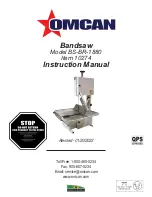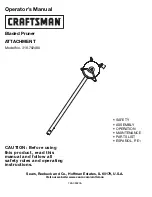
10 ENGLISH
For tool with lock-off button
CAUTION:
•
Do not pull the switch trigger hard without pressing in
the lock-off button. This can cause switch breakage.
To prevent the switch trigger from being accidentally
pulled, a lock-off button is provided.
To start the tool, depress the lock-off button and pull the
switch trigger. Release the switch trigger to stop.
WARNING:
•
For your safety, this tool is equipped with a lock-off
button which prevents the tool from unintended
starting. NEVER use the tool if it runs when you
simply pull the switch trigger without pressing the
lock-off button. Return tool to a Makita service
center for proper repairs BEFORE further usage.
•
NEVER tape down or defeat purpose and func
-
tion of lock-off button.
For tool with lock button
CAUTION:
•
Switch can be locked in "ON" position for ease
of operator comfort during extended use. Apply
caution when locking tool in "ON" position and
maintain firm grasp on tool.
To start the tool, simply pull the switch trigger. Release
the switch trigger to stop.
For continuous operation, pull the switch trigger, push in
the lock button and then release the switch trigger.
To stop the tool from the locked position, pull the switch
trigger fully, then release it.
ASSEMBLY
CAUTION:
•
Always be sure that the tool is switched off and unplugged
before adjusting or checking function on the tool.
Removing or installing saw blade
CAUTION:
•
Be sure the blade is installed with teeth pointing
up at the front of the tool.
•
Use only the Makita wrench to install or remove
the blade.
►
Fig.13:
1.
Hex wrench
2.
Shaft lock
3.
Loosen
4.
Tighten
To remove the blade, press the shaft lock so that the blade can
-
not revolve and use the wrench to loosen the hex bolt counter
-
clockwise. Then remove the hex bolt, outer flange and blade.
►
Fig.14:
1.
Inner flange
2.
Saw blade
3.
Outer flange
4.
Hex bolt
When changing blade, make sure to also clean upper and lower
blade guards of accumulated sawdust. Such efforts do not, however,
replace the need to check lower guard operation before each use.
For tool with the inner flange for other
than 15.88 mm hole-diameter saw blade
►
Fig.15:
1.
Mounting shaft
2.
Inner flange
3.
Saw
blade
4.
Outer flange
5.
Hex bolt
The inner flange has a certain diameter protrusion on
one side of it and a different diameter protrusion on the
other side. Choose a correct side on which protrusion
fits into the saw blade hole perfectly.
Next, mount the inner flange onto the mounting shaft so
that the correct side of protrusion on the inner flange faces
outward and then place saw blade and outer flange.
BE SURE TO TIGHTEN THE HEX BOLT CLOCKWISE SECURELY.
CAUTION:
•
Make sure that the protrusion "a" on the inner
flange that is positioned outside fits into the saw
blade hole "a" perfectly.
Mounting the blade on the
wrong side can result in the dangerous vibration.
For tool with the inner flange for a
15.88 mm hole-diameter saw blade
(country specific)
►
Fig.16:
1.
Mounting shaft
2.
Inner flange
3.
Saw
blade
4.
Outer flange
5.
Hex bolt
►
Fig.17:
1.
Mounting shaft
2.
Inner flange
3.
Saw
blade
4.
Outer flange
5.
Hex bolt
6.
Ring
Mount the inner flange with its recessed side facing outward
onto the mounting shaft and then place saw blade (with the
ring attached if needed), outer flange and hex bolt.
BE SURE TO TIGHTEN THE HEX BOLT CLOCKWISE SECURELY.
WARNING:
•
Before mounting the blade onto the spin-
dle, always be sure that the correct ring for
the blade's arbor hole you intend to use is
installed between the inner and the outer
flanges.
Use of the incorrect arbor hole ring
may result in the improper mounting of the blade
causing blade movement and severe vibration
resulting in possible loss of control during oper
-
ation and in serious personal injury.
Hex wrench storage
►
Fig.18:
1.
Hex wrench
When not in use, store the hex wrench as shown in the
figure to keep it from being lost.
Connecting a vacuum cleaner
(Optional accessory in some countries)
►
Fig.19:
1.
Dust nozzle
2.
Screw
3.
Lever
►
Fig.20:
1.
Vacuum cleaner
2.
Hose
When you wish to perform clean cutting operation,
connect a Makita vacuum cleaner to your tool.
Install the dust nozzle on the tool using the screw. Then
connect a hose of the vacuum cleaner to the dust noz-
zle as shown in the figure.
For tool without dust nozzle provided as a standard equipment,
replace the lever fixed on the lower guard to the one supplied with
the dust nozzle (optional accessory) at the same time when install-
ing the dust nozzle. Otherwise you will not be able to make a cut
because the lower guard movement is hindered by the dust nozzle.











































